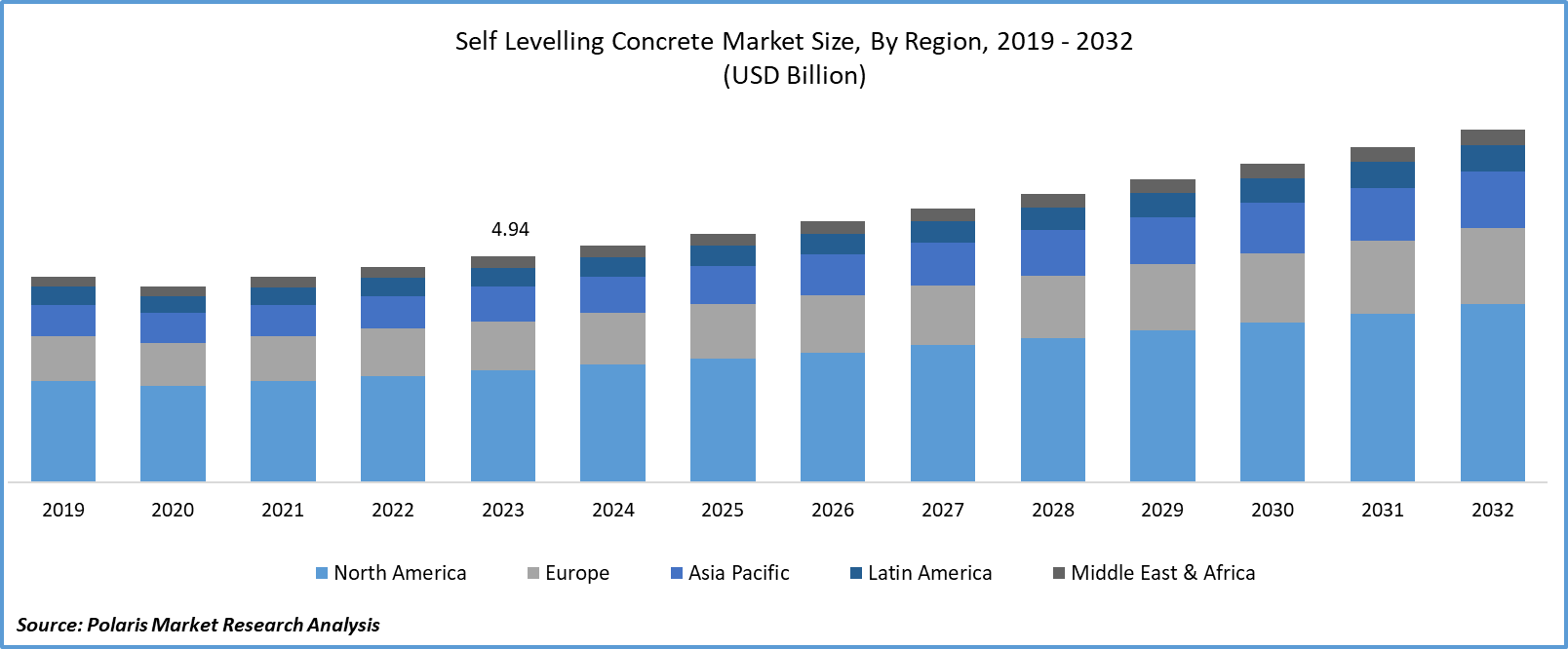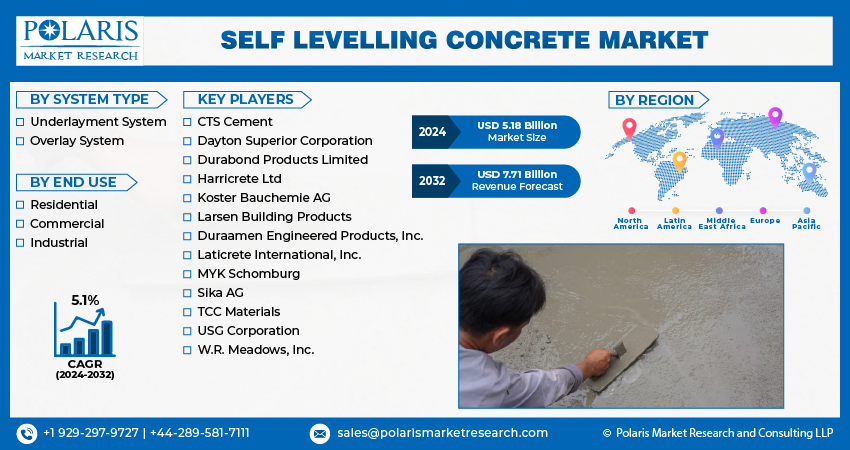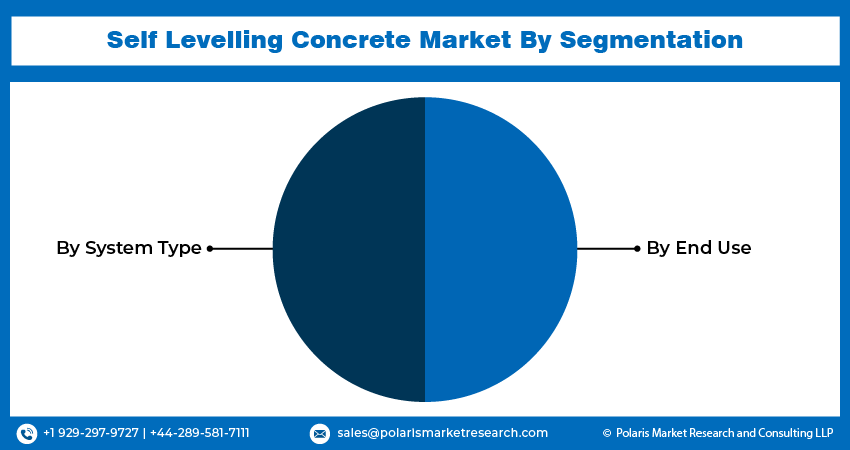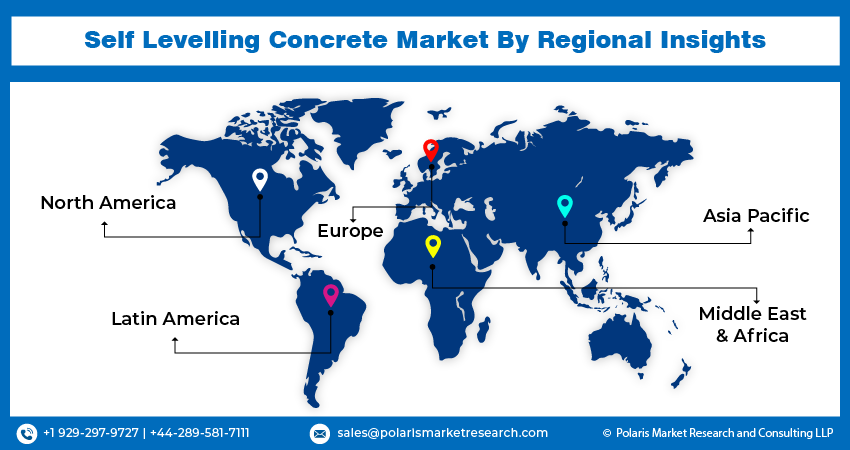
Self-levelling concrete market Share, Size, Trends, Industry Analysis Report
By System Type (Underlayment System, Overlay System), By End-use, By Region, And Segment Forecasts, 2024 - 2032
- Published Date:Feb-2024
- Pages: 118
- Format: PDF
- Report ID: PM4579
- Base Year: 2023
- Historical Data: 2019 – 2022
Report Outlook
Global self-levelling concrete market size was valued at USD 4.94 billion in 2023. The market is anticipated to grow from USD 5.18 billion in 2024 to USD 7.71 billion by 2032, exhibiting the CAGR of 5.1% during the forecast period.
Market Overview
The expansion of the construction industry, particularly in developing countries, coupled with increased demand for self-leveling concrete, is poised to drive significant growth in this sector. Self-leveling concrete is preferred due to its easy application process, which saves both time and labor costs while ensuring a high-quality surface finish. The rapid pace of industrialization & rapid growth in both commercial & residential construction projects further contributed to the self-levelling concrete market expansion.
- For instance, in 2019-20, the Indian government earmarked investment for infrastructure development and intends to invest USD 1.4 trillion over the ensuing five years. Moreover, the construction sector in India has experienced significant growth, with private equity and venture capital injections totaling USD 1.4 billion.
Moreover, ongoing self-levelling concrete market research and development (R&D) efforts aimed at enhancing the efficiency and performance characteristics of self-leveling concrete present promising self-levelling concrete market trends. Innovations in self-leveling concrete formulations, including improvements in strength, flexibility, and sustainability, are expected to drive its adoption in construction projects further worldwide.

To Understand More About this Research: Request a Free Sample Report
The self-levelling concrete market dynamics is rises due to the increasing requirements for smooth and flat flooring surfaces in construction projects. As architectural and design standards become more stringent, particularly in residential and commercial buildings, the need for flawless flooring materials becomes paramount. Self-leveling concrete addresses this demand by providing an efficient solution for achieving high levels of smoothness and flatness.
Further, self-levelling concrete market report covers self-leveling cement which is a specialized type of concrete designed to flow smoothly and level itself without the need for extensive manual intervention. It is commonly used to level uneven floors in residential, commercial, and industrial settings. The versatility of self-leveling cement makes it suitable for a wide range of substrates, including concrete, wood, and tile. Self-leveling floor compound is similar to self-leveling cement but may have different formulations tailored to specific applications or performance requirements. These compounds are often used to prepare subfloors for the installation of finished flooring materials such as tile, hardwood, or carpet. They can also be used to repair damaged or uneven concrete surfaces before applying a final floor finish.
Also, floor leveling compound is a general term that encompasses various materials used to level or smooth uneven surfaces. While some floor-leveling compounds may not be self-leveling and require manual spreading and leveling, others incorporate self-leveling properties for easier application. These compounds are used in both residential and commercial construction projects to prepare surfaces for flooring installation or repair. Additionally, advancements in material technology, such as self-leveling additives and polymer-modified formulations, contribute to the growth of the market by enhancing performance and versatility.

Growth Factors
Rise in construction sites coupled with urbanization
The self-leveling concrete market analysis is increases due to rising demand from various construction sites, including restaurants, educational institutions, and apartment complexes. These sectors require high-quality flooring solutions that offer durability and ease of installation, making self-leveling concrete an attractive option. Furthermore, the increasing pace of industrialization in developing nations contributes significantly to the expansion of the market. As these countries experience economic growth and urbanization, there is a corresponding rise in construction activities across residential, commercial, and industrial sectors, driving the need for advanced construction materials like self-leveling concrete.
Reduced labor costs and less turnaround time
Self-leveling concrete offers several advantages over traditional concrete mixes, primarily due to its unique properties and ease of use. One key advantage is its ability to reduce labor time significantly and costs associated with floor preparation and installation. Unlike conventional concrete mixes, which often require extensive manual leveling and finishing work to achieve a level and smooth surface, self-leveling concrete is formulated to flow easily and settle into place on its own. This characteristic eliminates the need for manual leveling efforts, reducing the amount of labor required during installation.
Because self-leveling concrete requires minimal intervention to achieve a smooth and level surface, it streamlines the construction process. Contractors can pour the material and rely on its self-leveling properties to create a uniform surface without the need for extensive manual adjustments. This efficiency translates into time savings, as the installation process is expedited compared to traditional concrete methods.
Moreover, self-leveling concrete enables contractors to achieve superior results with less effort. The material produces a consistently level surface with minimal imperfections, enhancing the overall quality of the finished floor. This superior finish can contribute to improved aesthetics and performance of the flooring system.
Restraining Factors
High cost
Self-leveling concrete typically comes at a higher cost compared to traditional concrete mixes. This cost factor can restrain its widespread adoption, particularly in projects with budget constraints. While self-leveling concrete offers excellent leveling properties, it may only be suitable for some construction applications. Its fluid nature makes it less suitable for vertical or overhead applications, limiting its versatility compared to traditional concrete.
Proper installation of self-leveling concrete requires skilled labor and specialized equipment. Contractors need to be trained in its application techniques to ensure optimal results. This requirement can be a barrier for some construction projects, especially those with limited access to skilled labor or equipment. Further, self-leveling concrete has a limited working time once mixed, typically ranging from 10 to 30 minutes. Contractors need to work quickly to pour and spread the material before it starts to set, which can be challenging for larger or more complex projects.
Report Segmentation
The market is primarily segmented based on system type, end use, and region.
|
By System Type |
By End Use |
By Region |
|
|
|
To Understand the Scope of this Report: Speak to Analyst
By System Type Insights
Underlayment systems segment accounted for the largest market share in 2023
In 2023, the Underlayment systems segment accounted for the largest market share. This dominance is primarily due to the expanding residential construction sector, which is responding to the increasing global population's need for housing. In-Home Construction 4, this concrete addresses shallow depressions in the subfloor, thus driving the demand for subfloor repairs. This concrete type ensures a smooth and level surface for flooring installation, effectively smoothing out minor irregularities in the ground.
Furthermore, underlayment systems allow for the achievement of the desired level with a thinner layer of self-leveling concrete. This not only saves material but also reduces the time required for installation and curing. As a result, contractors and builders can complete projects more efficiently and cost-effectively, driving the overall growth of the market for underlayment systems. The ability of underlayment systems to improve adhesion, reduce material usage, and expedite the construction process makes them highly desirable in various construction applications, contributing to the anticipated growth of the market.
By End Use Insights
The residential segment is expected to grow at the fastest rate during the forecast period.
The residential segment is expected to grow at the fastest rate during the forecast period. As homeowners prioritize renovations and improvements, the demand for self-leveling concrete is on the rise due to its easy installation process and its ability to create even surfaces. This trend is further fueled by the growing popularity of do-it-yourself (DIY) projects, where minimal human intervention is required to achieve smooth flooring levels. Additionally, increasing government subsidies for renovation endeavors are contributing to the growth of the residential sector's demand for self-leveling concrete, thereby driving overall market expansion.
Furthermore, the commercial segment dominated the market. This dominance is particularly evident in commercial ventures such as hotels, office complexes, & retail establishments, which necessitate expansive, flawlessly leveled floor surfaces. The surge in the utilization of self-leveling concrete is a key driver behind this trend, attributed to its capacity to deliver a uniform finish and simplified application procedures.
Commercial environments, with their high foot traffic, demand flooring solutions that offer both durability and visual appeal, making self-leveling concrete a preferred choice. Its ability to mitigate the risks of cracks and uneven surfaces while enhancing the aesthetic and functional aspects of the floor makes it particularly attractive. With increasing awareness of these advantages, building owners, architects, and contractors are embracing self-leveling concrete in the construction of new commercial structures.

Regional Insights
APAC accounted for the largest market share in 2023
In 2023, APAC accounted for the largest market share. The region's rapid growth is attributed to escalated construction endeavors and population expansion. Both commercial and residential ventures are experiencing heightened demand across the region. Government initiatives aimed at establishing industrial hubs, educational institutions, and healthcare facilities are poised to stimulate market expansion. Furthermore, the increasing industrialization in nations is anticipated to bolster growth even further.
For instance, in late 2022, the National Development and Reform Commission (NDRC) greenlit 109 fixed-asset investment initiatives. These projects, amounting to a total investment value of 1.48 trillion yuan, span across sectors such as transportation, energy, and water conservancy.
North America is expected to witness a significant CAGR during the forecast period.
North America is expected to witness a significant CAGR during the forecast period, primarily driven by a notable increase in investments towards home renovations and redevelopment projects. Homeowners and property developers are increasingly opting for self-leveling concrete to achieve flat and level surfaces in flooring applications. This trend is fueled by the desire to enhance property value, improve aesthetics, and address structural issues in older buildings.
Government initiatives aimed at enhancing construction and infrastructure development further bolster the demand for self-leveling concrete in North America. Various public sector projects, such as road construction, bridge repairs, and public building renovations, require high-quality flooring solutions. Self-leveling concrete is often preferred for sub-floor preparation and various finishing applications due to its efficiency and durability.
Further, technological advancements in self-leveling concrete formulations have led to the development of innovative products with improved performance and versatility. Manufacturers in North America are introducing self-leveling concrete solutions tailored to meet the specific needs of different applications, contributing to self levelling concrete industry growth.

Key Market Players & Competitive Insights
Self-levelling concrete market scope is in significant growth stage, with the pace of growth accelerating. This growth is marked by significant innovation driven by rapid technological advancements, particularly in response to increasing construction activities across many developing nations. Additionally, manufacturers are ramping up their research and development investments to create various additives and cement that enable smoother settling with minimal or no human intervention.
Some of the major players operating in the global market include:
- CTS Cement
- Dayton Superior Corporation
- Duraamen Engineered Products, Inc.
- Durabond Products Limited
- Harricrete Ltd
- Koster Bauchemie AG
- Larsen Building Products
- Laticrete International, Inc.
- MYK Schomburg
- Sika AG
- TCC Materials
- USG Corporation
- W.R. Meadows, Inc.
Recent Developments
- In March 2020, Mapei South Africa unveiled its latest addition to the product lineup with the introduction of ULTRAPLAN ECO 20, a self-leveling compound manufactured locally. This expansion of the company's product range represents a significant enhancement to its offerings in the construction materials sector.
Report Coverage
The self-levelling concrete market report emphasizes on key regions across the globe to provide better understanding of the product to the users. Also, the report provides market insights into recent developments, trends and analyzes the technologies that are gaining traction around the globe. Furthermore, the report covers in-depth qualitative analysis pertaining to various paradigm shifts associated with the transformation of these solutions.
The report provides detailed analysis of the market while focusing on various key aspects such as competitive analysis, system type, end use, and their futuristic growth opportunities.
Self-Levelling Concrete Market Report Scope
|
Report Attributes |
Details |
|
Market size value in 2024 |
USD 5.18 billion |
|
Revenue forecast in 2032 |
USD 7.71 billion |
|
CAGR |
5.1% from 2024 – 2032 |
|
Base year |
2023 |
|
Historical data |
2019 – 2022 |
|
Forecast period |
2024 – 2032 |
|
Quantitative units |
Revenue in USD million and CAGR from 2024 to 2032 |
|
Segments covered |
|
|
Regional scope |
|
|
Competitive Landscape |
|
|
Report Format |
|
|
Customization |
Report customization as per your requirements with respect to countries, region and segmentation. |
FAQ's
key companies in Self-Levelling Concrete Market are CTS Cement, Dayton Superior, Durabond Products, Harricrete
Self-levelling concrete market exhibiting the CAGR of 5.1% during the forecast period
The Self-Levelling Concrete Market report covering key segments are system type, end use, and region.
key driving factors in Self-Levelling Concrete Market are 1. Rise in construction sites coupled with urbanization
The global self levelling concrete market size is expected to reach USD 7.71 billion by 2032
